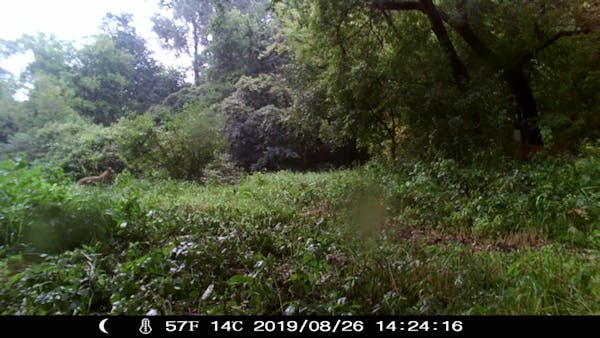Turns out the possible cougar wandering amid the brush in Eden Prairie is more likely a coyote.
A city resident took a photo of the animal as it sauntered near Purgatory Creek, south of Cold Stream Lane, and police shared the photo in a tweet, saying they were working with experts to identify the animal.
After closely examining the grainy photo from a trail camera, wildlife experts with the Minnesota Department of Natural Resources say the animal is a canine of some sort — likely a coyote. They came to that conclusion because the animal has a longer snout than a cougar and its ears are higher and more pointed than a feline's.
The false alarm wasn't the first cougar sighting reported in Eden Prairie this summer. Two weeks ago, police were told of a possible sighting near Staring Lake.
That same week, two cougar sightings were reported in Bloomington. Residents in the area of Chicago Avenue and 102nd Street reported seeing a large cat on two occasions over three days. They described the animal as looking like a cougar, but no photos were taken.
According to the DNR, 30 cougar sightings have been reported in Minnesota over the past 15 years.
Cougars were found in most of Minnesota before European settlement, the DNR website says. "Today, they are rarely seen but occasionally do appear," it says. "While evidence might suggest the animal's prevalence is increasing, the number of verified cougar observations indicates that cougar occurrence in Minnesota is the result of transient animals from the western Dakotas."
The website goes on to say that while some Minnesota cougar sightings do prove authentic, "many observations from trail cameras and tracks turn out to be cases of mistaken identify. Bobcats, house cats, coyotes, wolves, fishers and light-colored dogs have all been mistaken as cougars."
Even so, the DNR urges caution. If you encounter a cougar, it warns, don't run, but "face the cougar directly, raise your arms to make yourself appear larger and speak loudly and firmly."
Cougars are a protected species and may not be shot. Any sightings should be reported to law enforcement or conservation authorities.
Mary Lynn Smith • 612-673-4788
U.S. Steel won't get exception to pollution rules that protect wild rice, MPCA says

Taste of Minnesota to be enjoyed on the ground and in the air this year

Ex-Hennepin sheriff paid for drunk-driving damages with workers' comp

Souhan: This is KAT's chance to prove Flip Saunders was right

